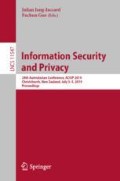Abstract
Mass surveillance attracts much of attentions nowadays. Evidences showed that some intelligence agencies try to monitor public’s communication by unconventional methods, for example, providing users subverted cryptographic algorithms and compelling them to use. To address this new situation, researchers proposed a series of formal analyses and security definitions. However, current researches are restrictive as they only considered a single surveillant setting. In reality, there may exist multiple surveillants for different governments or manufacturers. This paper initializes the analysis of security against subversion in a multi-surveillant setting. We consider the case where users could only use subverted algorithms from different sources to achieve a subliminal communication. We introduce a new security notion that the transmission of a real message is “undetectable”, which means all surveillants either think the users execute the subverted algorithms honestly to transmit an innocuous message, or consider users are using non-subverted algorithms. We present a concrete design and prove that it satisfies our security definition.
Access this chapter
Tax calculation will be finalised at checkout
Purchases are for personal use only
Notes
- 1.
In our model we expect the users to transmit \(\mathsf {msg}\) under any cover message. \(\mathcal {M}\) is independent of all users and surveillants, and generates messages with no extra requirement except looking innocent.
References
Bellare, M., Fuchsbauer, G., Scafuro, A.: NIZKs with an untrusted CRS: security in the face of parameter subversion. In: Cheon, J.H., Takagi, T. (eds.) ASIACRYPT 2016. LNCS, vol. 10032, pp. 777–804. Springer, Heidelberg (2016). https://doi.org/10.1007/978-3-662-53890-6_26
Bellare, M., Jaeger, J., Kane, D.: Mass-surveillance without the state: strongly undetectable algorithm-substitution attacks. In: ACM CCS, pp. 1431–1440 (2015)
Bellare, M., Paterson, K.G., Rogaway, P.: Security of symmetric encryption against mass surveillance. In: Garay, J.A., Gennaro, R. (eds.) CRYPTO 2014. LNCS, vol. 8616, pp. 1–19. Springer, Heidelberg (2014). https://doi.org/10.1007/978-3-662-44371-2_1
Bernstein, D.J., Lange, T., Niederhagen, R.: Dual EC: a standardized back door. In: Ryan, P.Y.A., Naccache, D., Quisquater, J.-J. (eds.) The New Codebreakers. LNCS, vol. 9100, pp. 256–281. Springer, Heidelberg (2016). https://doi.org/10.1007/978-3-662-49301-4_17
Chen, R., Mu, Y., Yang, G., Susilo, W., Guo, F., Zhang, M.: Cryptographic reverse firewall via malleable smooth projective hash functions. In: Cheon, J.H., Takagi, T. (eds.) ASIACRYPT 2016. LNCS, vol. 10031, pp. 844–876. Springer, Heidelberg (2016). https://doi.org/10.1007/978-3-662-53887-6_31
Degabriele, J.P., Farshim, P., Poettering, B.: A more cautious approach to security against mass surveillance. In: Leander, G. (ed.) FSE 2015. LNCS, vol. 9054, pp. 579–598. Springer, Heidelberg (2015). https://doi.org/10.1007/978-3-662-48116-5_28
Dodis, Y., Mironov, I., Stephens-Davidowitz, N.: Message transmission with reverse firewalls—secure communication on corrupted machines. In: Robshaw, M., Katz, J. (eds.) CRYPTO 2016. LNCS, vol. 9814, pp. 341–372. Springer, Heidelberg (2016). https://doi.org/10.1007/978-3-662-53018-4_13
Fischlin, M., Mazaheri, S.: Self-guarding cryptographic protocols against algorithm substitution attacks. In: CSF, pp. 76–90 (2018)
Horel, T., Park, S., Richelson, S., Vaikuntanathan, V.: How to subvert backdoored encryption: security against adversaries that decrypt all ciphertexts. In: ITCS (2019, to appear)
Mironov, I., Stephens-Davidowitz, N.: Cryptographic reverse firewalls. In: Oswald, E., Fischlin, M. (eds.) EUROCRYPT 2015. LNCS, vol. 9057, pp. 657–686. Springer, Heidelberg (2015). https://doi.org/10.1007/978-3-662-46803-6_22
Russell, A., Tang, Q., Yung, M., Zhou, H.-S.: Cliptography: clipping the power of kleptographic attacks. In: Cheon, J.H., Takagi, T. (eds.) ASIACRYPT 2016. LNCS, vol. 10032, pp. 34–64. Springer, Heidelberg (2016). https://doi.org/10.1007/978-3-662-53890-6_2
Russell, A., Tang, Q., Yung, M., Zhou, H.: Generic semantic security against a kleptographic adversary. In: ACM CCS, pp. 907–922 (2017)
Young, A., Yung, M.: The dark side of “Black-Box” cryptography or: should we trust capstone? In: Koblitz, N. (ed.) CRYPTO 1996. LNCS, vol. 1109, pp. 89–103. Springer, Heidelberg (1996). https://doi.org/10.1007/3-540-68697-5_8
Young, A., Yung, M.: Kleptography: using cryptography against cryptography. In: Fumy, W. (ed.) EUROCRYPT 1997. LNCS, vol. 1233, pp. 62–74. Springer, Heidelberg (1997). https://doi.org/10.1007/3-540-69053-0_6
Young, A., Yung, M.: The prevalence of kleptographic attacks on discrete-log based cryptosystems. In: Kaliski, B.S. (ed.) CRYPTO 1997. LNCS, vol. 1294, pp. 264–276. Springer, Heidelberg (1997). https://doi.org/10.1007/BFb0052241
Young, A., Yung, M.: Malicious cryptography: kleptographic aspects. In: Menezes, A. (ed.) CT-RSA 2005. LNCS, vol. 3376, pp. 7–18. Springer, Heidelberg (2005). https://doi.org/10.1007/978-3-540-30574-3_2
Acknowledgment
The work is supported partly by Beijing Natural Science Foundation (4182033) and National Cryptography Development Fund (MMJJ20180215). We sincerely thank anonymous reviewers for valuable comments, especially about the definition of cover message.
Author information
Authors and Affiliations
Corresponding author
Editor information
Editors and Affiliations
Rights and permissions
Copyright information
© 2019 Springer Nature Switzerland AG
About this paper
Cite this paper
Li, G., Liu, J., Zhang, Z. (2019). Security Against Subversion in a Multi-surveillant Setting. In: Jang-Jaccard, J., Guo, F. (eds) Information Security and Privacy. ACISP 2019. Lecture Notes in Computer Science(), vol 11547. Springer, Cham. https://doi.org/10.1007/978-3-030-21548-4_23
Download citation
DOI: https://doi.org/10.1007/978-3-030-21548-4_23
Published:
Publisher Name: Springer, Cham
Print ISBN: 978-3-030-21547-7
Online ISBN: 978-3-030-21548-4
eBook Packages: Computer ScienceComputer Science (R0)

